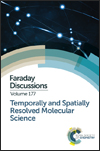Spatio-temporal correlations in aqueous systems: computational studies of static and dynamic heterogeneity by 2D-IR spectroscopy†
Abstract
Local heterogeneity is ubiquitous in natural aqueous systems. It can be caused locally by external biomolecular subsystems like proteins, DNA, micelles and reverse micelles, nanoscopic materials etc., but can also be intrinsic to the thermodynamic nature of the aqueous solution itself (like binary mixtures or at the gas–liquid interface). The altered dynamics of water in the presence of such diverse surfaces has attracted considerable attention in recent years. As these interfaces are quite narrow, only a few molecular layers thick, they are hard to study by conventional methods. The recent development of two dimensional infra-red (2D-IR) spectroscopy allows us to estimate length and time scales of such dynamics fairly accurately. In this work, we present a series of interesting studies employing two dimensional infra-red spectroscopy (2D-IR) to investigate (i) the heterogeneous dynamics of water inside reverse micelles of varying sizes, (ii) supercritical water near the Widom line that is known to exhibit pronounced density fluctuations and also study (iii) the collective and local polarization fluctuation of water molecules in the presence of several different proteins. The spatio-temporal correlation of confined water molecules inside reverse micelles of varying sizes is well captured through the spectral diffusion of corresponding 2D-IR spectra. In the case of supercritical water also, we observe a strong signature of dynamic heterogeneity from the elongated nature of the 2D-IR spectra. In this case the relaxation is ultrafast. We find remarkable agreement between the different tools employed to study the relaxation of density heterogeneity. For aqueous protein solutions, we find that the calculated dielectric constant of the respective systems unanimously shows a noticeable increment compared to that of neat water. However, the ‘effective’ dielectric constant for successive layers shows significant variation, with the layer adjacent to the protein having a much lower value. Relaxation is also slowest at the surface. We find that the dielectric constant achieves the bulk value at distances more than 3 nm from the surface of the protein.
- This article is part of the themed collection: Temporally and Spatially Resolved Molecular Science

 Please wait while we load your content...
Please wait while we load your content...